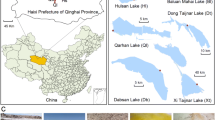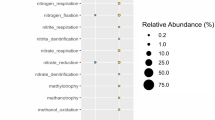Abstract
Understanding the distribution of bacteria is a major goal of microbial ecology which remains to be fully deciphered. In this study, a model 50 °C temperature gradient at a Northern Thailand hot spring was analyzed to determine how the bacterial communities were structured in the environment. Communities were examined through 16S rRNA gene amplification, denaturing gradient gel electrophoresis, and sequencing. The two major phyla, Cyanobacteria and Chloroflexi, showed characteristic distributions along the temperature gradient. Different clades were allocated at specific portions of the gradient. Comparisons of the bacterial communities along the temperature gradient showed sharp decreases of similarity at increasing temperature difference. Peaks of maximum richness were observed at 50 and 70 °C. This study contributes to explain how environmental conditions and microbial interactions can influence the distribution of specific bacterial clades and phyla shaping the structure of microbial communities in nature.






Similar content being viewed by others
References
Allewalt JP, Bateson MM, Revsbech NP, Slack K, Ward DM (2006) Effect of temperature and light on growth and photosynthesis by Synechococcus isolates typical of those predominating in the Octopus Spring Microbial Mat Community of Yellowstone National Park. Appl Environ Microbiol 72:544–550
Altschul SF, Gish W, Miller W, Myers EW, Lipman DJ (1990) Basic local alignment search tool. J Mol Biol 215:403–410
Baas-Becking LGM (1934) Geobiologie of inleiding tot de milieukunde. van Stockum, W.P. & Zoon, Amsterdan
Bell T, Ager D, Song J-I, Newman JA, Thompson IP, Lilley AK, van der Gast CJ (2005) Larger islands house more bacterial taxa. Science 308:1884
Blank CE, Cady SL, Pace NR (2002) Microbial composition of near-boiling silica depositing thermal springs throughout Yellostone National Park. Appl Environ Microbiol 68:5123–5135
Bohorquez LC, Delgado-Serrano L, López G, Osorio-Forero C, Klepac-Ceraj V, Kolter R, Junca H, Baena S, Zambrano MM (2012) In-depth characterization via complementing culture-independent approaches of the microbial community in an acidic hot spring of the Colombian Andes. Microb Ecol 63:103–115
Brock TD (1978) Thermophilic microorganisms and life at high temperatures. Springer, New York
Curtis TP, Sloan WT, Scannell JW (2002) Estimating prokaryotic diversity and its limits. Proc Natl Acad Sci U S A 99:10494–10499
Fenchel T, Finlay BJ (2003) Is microbial diversity fundamentally different from biodiversity of larger animals and plants? Eur J Protistol 39:486–490
Gonzalez JM, Ortiz-Martinez A, Gonzalez-del Valle MA, Laiz L, Saiz-Jimenez C (2003) An efficient strategy for screening large cloned libraries of amplified 16S rDNA sequences from complex environmental communities. J Microbiol Meth 55:459–463
Harte J, McCarthy S, Taylor K, Kinzig A, Fischer ML (1999) Estimating species-area relationships from plot to landscape scale using species spatial-turnover data. Oikos 86:45–54
Hill TCJ, Walsh KA, Harris JA, Moffett BF (2003) Using ecological diversity measures with bacterial communities. FEMS Microbiol Ecol 43:1–11
Hongmei J, Aitchison JC, Lacap DC, Peerapornpisal Y, Sompong U, Pointing SB (2005) Community phylogenetic analysis of moderately thermophilic cyanobacterial mats from China, the Philippines and Thailand. Extremophiles 9:325–332
Horner-Devine MC, Lage M, Hughes JB, Bohannan BJM (2004) A taxa-area relationship for bacteria. Nature 432:750–753
Hughes JB, Hellmann JJ (2005) The application of rarefaction techniques to molecular inventories of microbial diversity. Methods Enzymol 397:292–308
Itoh T, Iino T (2013) Phylogeny and biological features of thermophiles. In: Satyanarayana T, Littlechild J, Kawarabayasi Y (eds) Thermophilic microbes in environmental and industrial biotechnology: Biotechnology of thermophiles. Springer, Dordrecht
Jessup CM, Kassen R, Forde SE, Kerr B, Buckling A, Rainey PB, Bohannan BJM (2004) Big questions, small worlds: microbial model systems in ecology. Trends Ecol Evol 19:189–197
Klatt CG, Bryant DA, Ward DM (2007) Comparative genomics provides evidence for the 3-hydroxypropionate autotrophic pathway in filamentous anoxygenic phototrophic bacteria and in hot spring microbial mats. Environ Microbiol 9:2067–2078
Kubo K, Knittel K, Amann R, Fukui M, Matsuura K (2011) Sulfur metabolizing bacterial populations in microbial mats of the Nakabusa Hot Spring. Syst Appl Microbiol 34:293–302
Lane DJ (1991) 16S/23S rRNA sequencing. In: Stackebrandt E, Goodfellow M (eds) Nucleic acid techniques in bacterial systematics. Wiley, Chichester, pp 205–248
Lawton JH (1999) Are there general laws on ecology? Oikos 84:177–192
Mackenzie R, Pedrós-Alió C, Díez B (2013) Bacterial composition of microbial mats in hot springs in Northern Patagonia: variations with seasons and temperature. Extremophiles 17:123–136
Madigan M, Martinko JM, Parker J (2003) Brock biology of microorganisms. Prentice Hall Inc, New Jersey
Martiny JBH, Bohannan BJM, Brown JH, Colwell RK, Fuhrman JA, Green JL, Horner-Devine MC, Kane M, Krumins JA, Kuske CR, Morin PJ, Naeem S, Øvreås L, Reysenbach AL, Smith VH, Staley JT (2006) Microbial biogeography: putting microorganisms on the map. Nat Rev Microbiol 4:102–112
Meyer-Dombard DR, Shock EL, Amend JP (2005) Archaeal and bacterial communities in geochemically diverse hot springs of Yellowstone National Park USA. Geobiology 3:211–227
Miller SR, Strong AL, Jones KL, Ungerer MC (2009) Bar-coded pyrosequencing reveals shared bacterial community properties along the temperature gradients of two alkaline hot springs in Yellowstone National Park. Appl Environ Microbiol 75:4565–4572
Moyer CL, Dobbs FC, Karl DM (1995) Phylogenetic diversity of the bacterial community from a microbial mat at an active, hydrothermal vent system, Loihi Seamount, Hawaii. Appl Environ Microbiol 61:1555–1562
Muyzer G, de Waal EC, Uitterlinden AG (1993) Profiling of complex microbial populations by denaturing gradient gel electrophoresis analysis of polymerase chain reaction-amplified genes coding for 16S rRNA. Appl Environ Microbiol 59:695–700
Nübel U, García-Pichel F, Muyzer G (1997) PCR primers to amplify 16S rRNA genes from Cyanobacteria. Appl Environ Microbiol 63:3327–3332
Oksanen J, Blanchet FG, Kindt R, Legendre P, Minchin PR, O’Hara RB, Simpson GL, Solymos P, Stevens HH, Wagner, H (2011) Vegan: community ecology package. R package v.2.0-2. http://CRAN.R-project.org/package=vegan (last visited May 6th, 2014)
Portillo MC, Gonzalez JM (2008) Statistical differences between molecular fingerprints from microbial communities. Anton Leeuw Int J Mol Microbiol 94:157–163
Portillo MC, Gonzalez JM (2009) Members of the Candidate Division OP10 are spread in a variety of environments. World J Microbiol Biotechnol 25:347–352
Portillo MC, Sririn V, Kanoksilapatham W, Gonzalez JM (2009) Differential microbial communities in hot spring mats from Western Thailand. Extremophiles 13:321–331
Portillo MC, Saiz-Jimenez C, Gonzalez JM (2009) Molecular characterization of total and metabolically active bacterial communities of “white colonizations” in the Altamira Cave, Spain. Res Microbiol 160:41–47
Prosser J (2012) Ecosystem processes and interactions in a morass of diversity. FEMS Microbiol Ecol 81:507–519
Prosser JI, Bohannan BJM, Curtis TP, Ellis RJ, Firestone MK, Freckleton RP, Green JL, Green LE, Killham K, Lennon JJ, Osborn AM, Solan M, van der Gast CJ, Young JPW (2007) The role of ecological theory in microbial ecology. Nat Rev Microbiol 5:384–392
Rosselló-Mora R, Amann R (2001) The species concept for prokaryotes. FEMS Microbiol Rev 25:39–67
Sheridan RP, Ulik T (1976) Adaptive photosynthesis responses to temperature extremes by the thermophilic cyanophyte Synechococcus lividus. J Phycol 12:255–261
Skirnisdottir S, Hreggvidsson GO, Hjorleifsdottir S, Marteinsson VT, Petursdottir SK, Holts O, Kristjansson JK (2000) Influence of sulfide and temperature on species composition and community structure of hot spring microbial mats. Appl Environ Microbiol 66:2835–2841
Stetter KO, Fiala G, Huber G, Huber R, Segerer A (1990) Hyperthermophilic microorganisms. FEMS Microbiol Rev 75:117–124
Stott MB, Crowe MA, Mountain BW, Smirnova AV, Hou S, Alam M, Dunfield PF (2008) Isolation of novel bacteria, including a candidate division, from geothermal soils in New Zealand. Environ Microbiol 10:2030–2041
Strimmer K, von Haeseler A (1996) Quartet puzzling: a quartet maximum likelihood method for reconstructing tree topologies. Mol Biol Evol 13:964–969
Tamaki H, Tanaka Y, Matsuzawa H, Maramatsu M, Meng XY, Hanada S, Mori K, Kamagata Y (2011) Armatimonas rosea, gen. nov., sp. nov., of a novel bacterial phylum, Armatimonadetes, phyl. nov., formally called the candidate phylum OP10. Int J Syst Evol Microbiol 61:1442–1447
Telford RJ, Vandvik V, Birks HJB (2006) Dispersal limitations matter for microbial morphospecies. Science 312:1015–1015
Thompson JD, Higgins DG, Gibson TJ (1994) CLUSTAL W: improving the sensitivity of progressive multiple sequence alignment through sequence weighting, position specific gap penalties and weight matrix-choice. Nucleic Acids Res 22:4673–4680
van der Meer MTJ, Schouten S, de Leeuw JW, Ward DM (2003) Compound-specific isotopic fractionation patterns suggest different carbon metabolism among Chloroflexus-like bacteria in hot-spring microbial mats. Appl Environ Microbiol 69:6000–6006
Ward DM, Weller R, Bateson MM (1990) 16S rRNA sequences reveal uncultured inhabitants of a well-studied thermal community. FEMS Microbiol Rev 75:105–116
Ward DM, Ferris MJ, Nold SC, Bateson MM (1998) A natural view of microbial biodiversity hot spring cyanobacterial mat communities. Microbiol Mol Biol Rev 62:1353–1370
Whitfield J (2005) Biogeography: is everything everywhere? Science 310:960–961
Whitman WB, Coleman DC, Wiebe WJ (1998) Prokaryotes: the unseen majority. Proc Natl Acad Sci U S A 95:6578–6583
Wiegel J (1990) Temperature spans for growth: hypothesis and discussion. FEMS Microbiol Rev 75:155–170
Woodward G, Dybkjær JB, Ólafsson JS, Gíslason GM, Hannesdóttir ER, Friberg N (2010) Sentinel systems on the razor’s edge: effects of warming on Arctic geothermal stream ecosystems. Glob Chang Biol 16:1979–1991
Acknowledgments
JMG and MCP acknowledge funding through grants from the Spanish Ministry of Science and Innovation, CGL2009-12328/BOS and CSD2009-00006, and the Regional Government of Andalusia (BIO288). FEDER funds participated in this support. WK acknowledges funding through grants from the Scientific Promotion and Development Fund, Faculty of Science, Silpakorn University, and the Silpakorn University Research and Development Institution.
Author information
Authors and Affiliations
Corresponding author
Electronic Supplementary Material
Below is the link to the electronic supplementary material.
ESM 1
(PDF 685 kb)
Rights and permissions
About this article
Cite this article
Cuecas, A., Portillo, M.C., Kanoksilapatham, W. et al. Bacterial Distribution Along a 50 °C Temperature Gradient Reveals a Parceled Out Hot Spring Environment. Microb Ecol 68, 729–739 (2014). https://doi.org/10.1007/s00248-014-0437-y
Received:
Accepted:
Published:
Issue Date:
DOI: https://doi.org/10.1007/s00248-014-0437-y




